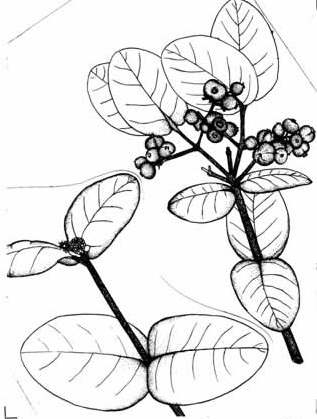
Psidium is a genus of trees and shrubs in the family Myrtaceae. It is native to warmer parts of the Western Hemisphere. Many of the species bear edible fruits, and for this reason several are cultivated commercially. The most popularly cultivated species is the common guava, Psidium guajava.

Myrciaria is a genus of large shrubs and small trees described as a genus in 1856. It is native to Central and South America, Mexico, and the West Indies, with many of the species endemic to Brazil. Common names include hivapuru, sabará, and ybapuru.

Plinia is a genus of flowering plants in the myrtle family, Myrtaceae described by Linnaeus in 1753. It is native to Central and South America as well as the West Indies.
Eugenia brevistyla is a species of plant in the family Myrtaceae. It is endemic to Brazil. Under its synonym Calycorectes australis, it was regarded as endangered, being threatened by habitat loss.
Myrcia acutissima is a species of plant in the family Myrtaceae. It is endemic to Jamaica.
Myrcia arenicola is a species of plant in the family Myrtaceae. It is endemic to western Cuba.
Myrcia hanoverensis is a species of plant in the family Myrtaceae. It is endemic to north-western Jamaica. It is threatened by habitat loss.
Myrcia pozasiana is a species of plant in the family Myrtaceae. It is endemic to Cuba.
Myrcia neocambessedeana was a species of plant in the family Myrtaceae. It was endemic to Brazil.
Myrcia magnifolia is a species of plant in the family Myrtaceae. It is endemic to southeast Brazil. Under its synonym Gomidesia magnifolia, it was classed as endangered.

Myrcia sintenisiana is a species of flowering plant in the family Myrtaceae. It is endemic to Puerto Rico, where it is limited to the Luquillo Mountains. It occurs in El Yunque National Forest in dwarf forest habitat on wet mountain ridges. Its common name is beruquillo.
Myrcia clarendonensis is a species of plant in the family Myrtaceae. It is endemic to Jamaica.
Mitranthes macrophylla is a species of plant in the family Myrtaceae. It is endemic to Jamaica. It is threatened by habitat loss.
Myrcia chionantha is a species of plant in the family Myrtaceae. It is endemic to Jamaica.
Myrcia maestrensis is a species of plant in the family Myrtaceae. It is endemic to Cuba.
Myrcia manacalensis is a species of plant in the family Myrtaceae. It is endemic to Cuba.
Myrciaria plinioides, commonly known as camboim, cambuim, or cambuí, is a species of plant in the family Myrtaceae. It is a shrub that is endemic to Rio Grande do Sul in the south of Brazil.

Myrcia guianensis (pedra-ume-caá) is a species of plant in the genus Myrcia of the family Myrtaceae native to South America.

Myrteae is the largest tribe in the plant family Myrtaceae. It includes most of the species of the family that have fleshy fruits.
Myrciaria rojasii is a species of plant in the family Myrtaceae. It is endemic to west-central Brazil and Paraguay. It was first described in 1963 by Carlos Maria Diego Enrique Legrand.






